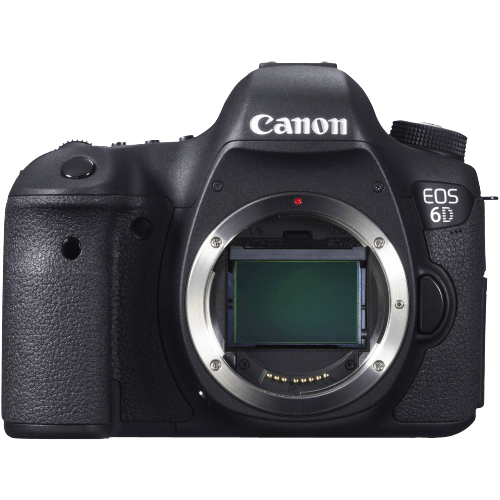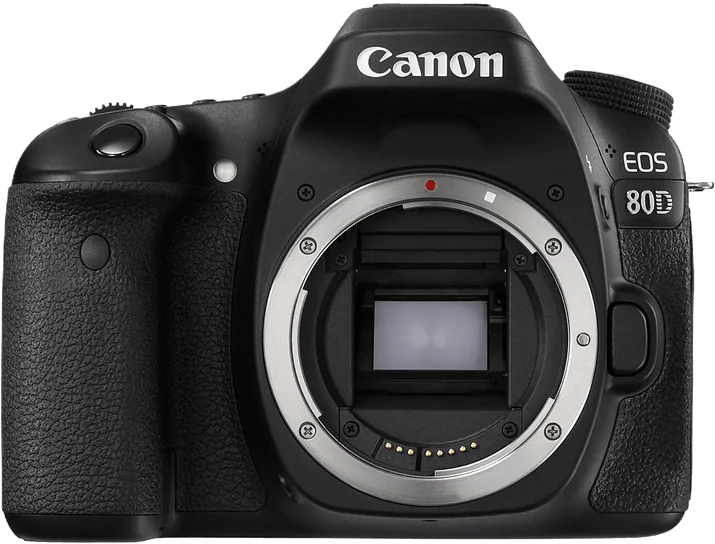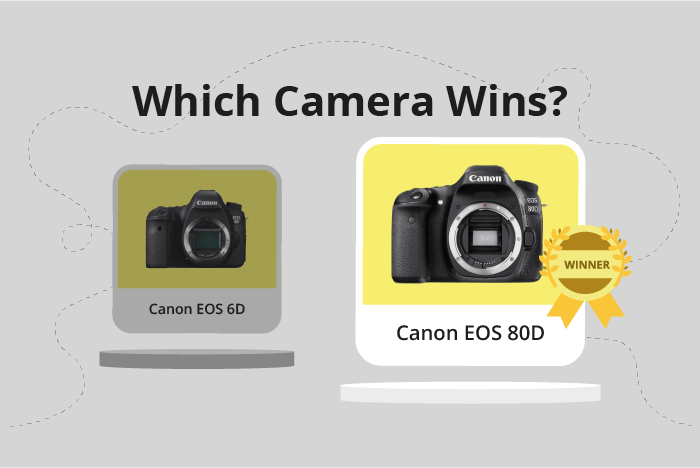Canon EOS 6D vs EOS 80D Comparison
Canon EOS 6D

Canon EOS 80D

The Canon EOS 80D outperforms the Canon EOS 6D with a score of 64/100 compared to 59/100. Both cameras are DSLRs and share some common specifications. They have similar sizes, with the EOS 6D measuring 145 x 111 x 71mm and the EOS 80D at 139 x 105 x 79mm. The EOS 80D is also slightly lighter, weighing 730g compared to the EOS 6D’s 770g.
The EOS 80D has the advantage of being released in 2016, making it a newer model with a more affordable launch price of $1200, compared to the EOS 6D’s $2099 launch price in 2012. However, the EOS 6D may have some benefits that are not reflected in the score.
Taking these points into consideration, the Canon EOS 80D stands out as a better camera with a higher score and more affordable price, while the EOS 6D may still appeal to some users due to its specific features or personal preferences.
Canon EOS 6D vs EOS 80D Overview and Optics
The Canon EOS 80D outperforms the Canon EOS 6D in optics, scoring 63/100 compared to the 6D’s 61/100. Both cameras share several common specifications, such as a CMOS sensor, no image stabilization, and compatibility with Canon EF lenses. However, there are key differences that contribute to the 80D’s higher optics score.
The Canon EOS 80D has a higher megapixel count at 24.2, compared to the 6D’s 20.2, allowing it to capture more detail in images. Additionally, the 80D boasts a faster shooting speed of 7 frames per second, while the 6D only manages 4.5. This makes the 80D more suitable for capturing fast-moving subjects or action shots. The 80D also has a more advanced processor, the Digic 6, which contributes to its faster performance.
On the other hand, the Canon EOS 6D has a full-frame sensor, providing a larger sensor size than the 80D’s APS-C sensor. This results in better image quality, particularly in low-light situations. Furthermore, the 6D has a higher DXOMARK score for the sensor at 82, compared to the 80D’s 79, indicating its superior sensor performance.
Despite the 6D’s advantages in sensor size and performance, the Canon EOS 80D’s higher megapixel count, faster shooting speed, and more advanced processor make it the better choice for optics. The 6D’s full-frame sensor and higher DXOMARK score cannot compensate for its lower overall optics score. In the end, the Canon EOS 80D is the superior camera when it comes to optics.
Canon EOS 6D vs EOS 80D Video Performance
When comparing the video capabilities of the Canon EOS 6D and Canon EOS 80D, the EOS 80D emerges as the clear winner with a video score of 70/100, while the EOS 6D lags behind with a score of 43/100. Both cameras feature Full HD video resolution and have maximum video dimensions of 1920 x 1080. However, the EOS 80D outperforms the EOS 6D in several aspects.
The Canon EOS 80D surpasses the EOS 6D with its higher maximum video frame rate of 60fps, which allows for smoother and more detailed video capture, compared to the EOS 6D’s 30fps. This difference in frame rate is crucial for capturing fast-paced action and sports footage. Moreover, the EOS 80D includes built-in time-lapse functionality, which enables users to create stunning time-lapse videos without the need for additional software or equipment.
On the other hand, the Canon EOS 6D does not hold any significant advantages over the EOS 80D in terms of video capabilities. Its lower video score and lack of time-lapse functionality make it less suitable for videographers who require advanced features and performance.
In comparing the Canon EOS 6D and EOS 80D, it is evident that the EOS 80D is the superior choice for those prioritizing video capabilities. Its higher video score, faster maximum frame rate, and built-in time-lapse functionality provide users with the tools and performance necessary for capturing high-quality video footage. Conversely, the EOS 6D falls short in these areas, making it less suitable for those focusing on videography.
Canon EOS 6D vs EOS 80D Features and Benefits
The Canon EOS 80D outperforms the Canon EOS 6D in features, with a score of 70 to the 6D’s 57. Both cameras share some common specifications, such as a 3-inch screen size and a screen resolution of 1,040,000 dots. They also both have Wi-Fi, but neither has Bluetooth.
The EOS 80D’s higher feature score results from its touchscreen and flip screen capabilities, which the 6D lacks. These features provide added convenience and flexibility when composing and reviewing images. The EOS 80D’s touchscreen allows for quick and easy adjustments to settings, while the flip screen enables shooting from various angles and positions.
On the other hand, the EOS 6D has GPS functionality, which the 80D does not. This feature allows photographers to geotag their images, enabling the tracking of shooting locations and simplifying organization. However, this advantage does not outweigh the benefits provided by the 80D’s touchscreen and flip screen.
In comparing the features of the Canon EOS 6D and EOS 80D, it is clear that the 80D offers more versatility and convenience with its touchscreen and flip screen capabilities. The 6D’s GPS functionality may be an advantage to some photographers, but it is not enough to surpass the 80D’s overall superior feature set. Therefore, the Canon EOS 80D stands out as the better camera in terms of features.
Canon EOS 6D vs EOS 80D Storage and Battery
The Canon EOS 6D narrowly wins in storage and battery with a score of 45/100, while the Canon EOS 80D scores 43/100. Both cameras have a single memory card slot and accept SD, SDHC, and SDXC cards. However, the EOS 80D is compatible with UHS-I cards, offering faster transfer speeds.
The EOS 6D outperforms the EOS 80D in battery life, providing 1090 shots per charge compared to the EOS 80D’s 960 shots. Both cameras use the same battery type, but the EOS 6D uses the LP-E6, while the EOS 80D uses the LP-E6N. Neither camera supports USB charging.
While the EOS 6D has a slightly longer battery life, the EOS 80D offers compatibility with faster memory cards. This difference in performance may not be significant for casual photographers but can be a deciding factor for professionals. Ultimately, the choice between these two cameras in terms of storage and battery will depend on the user’s priorities and needs.
Alternatives to the Canon EOS 6D and EOS 80D
Are you still undecided about which camera is right for you? Have a look at these popular comparisons that feature the Canon EOS 6D or the Canon EOS 80D:

